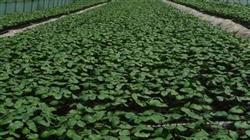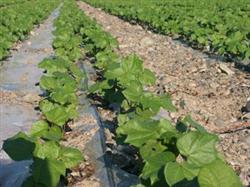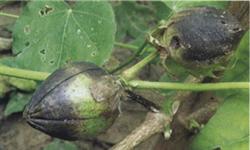The Seedling Seedling and transplanting technique of Cotton conjoined Seedling

Conjoined seedling separation and transplanting is a brand-new cotton cultivation model, in which every cultivation technical link is closely linked and inseparable. In the process of implementation, it must be closely linked in order to give full play to its systematic effect. The four major links are described as follows: (1) Seedling and transplanting of conjoined seedlings, and the traditional seedling raising methods have been thoroughly reformed. Mainly: do not make a bowl, the sowing date is postponed to around April 20, use a special seeder in the seedling pond, connect a single grain, sow quickly, raise cotyledon seedlings; special seedling transplanter, do not hurt roots, do not hurt leaves, rapid seedling division, bowl body whole, with soil feet, handling convenience, compared with ordinary nutrition bowl seedlings per mu, save about 100 yuan, save 2.5 workers, save 375 grams, save 90% of the bed. The specific operating procedures are as follows: 1. The seedlings per mu of soil should be filled with more than 200 kilograms of rotten fertile nutritious soil. 2. Make the bed to dig the nursery pond with a depth of 7cm, a width of 133.3 cm and a length of 165cm. 3. Fill the soil with nutritious soil, the pond is full, knead and step on it. 4. Sowing begins around April 20 and ends before May 1, sowing as planned. One night before sowing, there was enough water in the pond, and on the second morning, a single seed was sown with a locator, covered with 1.5 cm thick wet soil and gently pressed with 1-2 layers of plastic film. 5. after the seedlings came out, the seedlings were gradually opened for ventilation for 4 days, and then covered day and night for 4 days. 6. Transplant the cotyledon seedlings one by one with a seedling divider and transport them to the field for transplanting. (2) when transplanting sparsely, we should mainly do a good job in the following two aspects: one is to reduce the density to about 1500 plants / mu, to develop sufficient nutrients, so that the boll rate per plant will rise to more than 40%, and the number of bolls will reach more than 50; the second is to open a good pond, bring enough water and bring good medicine to realize that cotton can live as soon as it is planted, grow as soon as it is alive, show buds early, blossom early, bear more peaches and bear big peaches. The main methods are as follows: 1, select good stubble, cover good film generally with 200 cm as a combination, wheat amplitude 80 cm, reserved space 120 cm, blank middle row application (trench) urea 15 kg / mu, calcium superphosphate 25 kg / mu, potassium chloride fertilizer 15 kg / mu as base fertilizer, knead, spray enough herbicide, cover 100 cm plastic film. 2. Fix the hole and open the pond with a special pond opener every 40cm to 60cm on both sides of the plastic film, reaching the standard of intact mouth wall, consistent depth and smooth bottom of the pond. 1500 healthy seedlings with intact bowl body are planted per mu. 3. Pour good water, take good medicine, cover the cotton seedlings and plant them into the pond, pour the bean (cake) pulp water one by one with a teapot (retting with 1.25kg bean (cake) powder per mu) 1520kg, and then use the sprayer (to the sprinkler) to sprinkle 15kg Chlorheng 101 and Chlorheng No. 3 1500 times mixture to prevent insect pests and diseases; when the water and medicine are dry, the roots of cotton plants are congested into the shape of steamed bread with wet soil. (3) to simplify the management of conjoined seedlings and transplanting cotton, everything should be simplified in cultivation and management. Under the condition of rational use of herbicides and full coverage (seedling stage: empty line covered with plastic film, empty width; in the middle stage: cotton line does not uncover plastic film, wheat (bean, oil) stubble high stubble and late stubble late; in the later stage: full seedling), do not weed, do not plough, do not prune, do not wipe buds, do not remove old leaves, do not dig moisture (only open edge moisture, waist moisture). There are only three things to do in management: 1. Before and after July 15, when the cotton has bloomed two flowers, 25 kilograms of urea will be evenly divided one by one after rain and placed on the flat ground 15 centimeters away from the outside of the cotton root. Hang the stubble with a small tractor, open a ditch to turn the soil and cover the fertilizer, and then slightly arrange and cultivate the cotton rhizosphere with a shovel, so that the rows are cotton ridges and there are soil moisture ditches in the rows. In this way, we not only put out the stubble, chase the fertilizer, but also open the soil moisture, obstruct the roots, and kill many birds with one stone. 2. In order to achieve a certain leaf area index in the whole field, it is necessary to leave public branches and elongate fruit branches skillfully under the premise of full seedlings. 2. If the top sports seedlings are divided and transplanted into cotton, the row spacing is wide, the plant spacing is large, and the density is sparse. The practice is: the public branch of ① will not go, and it will be modified in advance. Six leaves of the male branch were removed from the top, so that the growth of the main culm was not limited, nor did it cause shade in the later stage, forcing the early-growing fruit branches to bear more peaches; ② beat the top properly in advance (Greater Heat Center). Take advantage of the cotton plant growth peak to go to the top, press its top growth advantage, make the nourishment spin, fruit branch elongation (especially the top four), send the cotton plant into a cylindrical shape, so that more early peach, big peach. 3. Less pest control and sports seedling transplanting has good root system and stable growth, and they are all transgenic insect-resistant hybrid cotton, and do not engage in excessive pest control. The main measures are: early treatment, encirclement, rapid treatment of blind bug bugs; investigation and treatment of red spiders; no treatment, less treatment, surprise treatment of cotton bollworm, generally the second generation is not treated, the third and fourth generations are only treated twice, and under special circumstances, surprise control is carried out for two times. At the same time, according to the specific situation, timely control of Verticillium wilt and late drug-resistant beet armyworm, Spodoptera litura. (4) Promotion and control combined with conjoined seedling separation and transplanting, the central idea of cotton growth period management is: giving priority to promotion, supplemented by control, combination of promotion and control, scientific and coordinated management, promoting cotton to grow big, extend more fruit branches, more fruit nodes, more buds, more flowers, more bolls, more peaches, early bolls, and good flowers. The methods are as follows: 1. Increase investment in fertilizer application with 25 kg of pure nitrogen, 6 kg of pure phosphorus and 8 kg of pure potassium per mu. When conditions permit, some organic fertilizers should also be applied. Generally, the basal fertilizer was applied before transplanting, the flower and boll fertilizer was applied again at the flower and boll stage, and the top fertilizer was applied at the topping stage, and the fertilizer was used for three times, and the distribution ratio was 4 ∶ 5 ∶ 1. In the later stage of cotton, trace elements such as boron, zinc, potassium dihydrogen phosphate, 920 and other trace elements fertilizers and hormones were sprayed on cotton leaves to promote cotton to bear more peaches and produce big peaches. 2. Spraying proper amount of regulator in the flower bud stage of cotton, when the cotton plant has the trend of overgrowth, spraying 1-2 buds per mu to promote the multiple buds and more flowering of cotton, so as to achieve the purpose of suppressing growth and stable growth. After the cotton was topped and the four sets on the cotton plant had been elongated, 2-3 propranolol was used to control the excessive lateral elongation of the fruit branch of the cotton plant, so as to achieve the purpose of dense fruit and steady growth. 3. Timely use of ethephon sports seedlings to transplant cotton has strong growth potential, strong stamina, and the upper, middle and lower peaches mature the same. In order to collect early flowers, collect flowers and promote unified and centralized opening of catkins, 250 grams of ethephon per mu was sprayed after October 15 to achieve the end of flower harvesting at the end of October.
- Prev

Careful use of Disease Prevention and Fungicides in Cotton Seedling stage
When cotton seedlings encounter low temperature, overcast and rainy weather, it is easy to be attacked by bacteria, resulting in dead seedlings, especially anthracnose and Verticillium wilt, which will cause irreparable huge losses. therefore, the prevention and treatment of cotton seedlings can not be ignored. 1, there are two types of fungicides, when choosing to use fungicides, you should.
- Next

Prevention and control of cotton boll rot
First, poor light, suitable for bacterial infection, diseases are often serious, cotton boll rot is also more serious. According to the type of cotton boll disease, cotton boll rot is caused by many kinds of bacteria. In the rainy years of summer and autumn in the cotton area of our province, the humidity of the cotton field is higher, the closure is heavier, and ventilation accounts for 28.3% of boll disease. Our province rains in late August.
Related
- The first cup of black tea in spring, the flavor and history of tea gardens in Kenya, Africa
- The computer can not only choose potatoes, but also grow tea rice. AI will grow winter oolong tea champion.
- It is not only the inflated tea bitten by insects, but also engraved with the four seasons tea in Beipu.
- The Oriental Beauty Tea Festival in Zhuxian County takes the stage at the weekend to experience the plus-size feast of oil tea.
- & quot; Oriental Beauty Tea & Exploration of Emei in Hsinchu, the hometown of quot;
- The new variety of strawberry "Tainong 1" dessert is the first choice with mellow aroma. Crimson gorgeous
- History of Tea in Taiwan: from Wild Inner Mountain to Export Tea Garden
- Two types of Taiwan Oriental Beauty Black Tea won the British three-Star Award for Childhood Tea Xiang Zhang Jiaqi changed from pilot to champion tea maker.
- Banana species and varieties: the planting history of Taiwan Xianren banana and dwarf banana is long, is banana disease resistant?
- Coffee planting Technology: Qianjie Coffee from Seedling to harvesting

